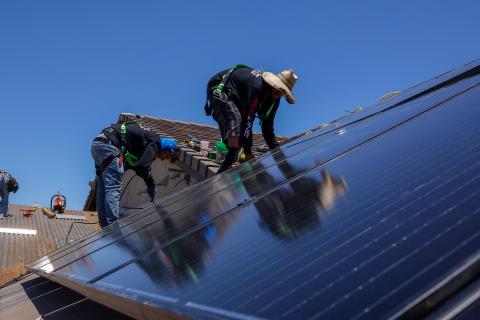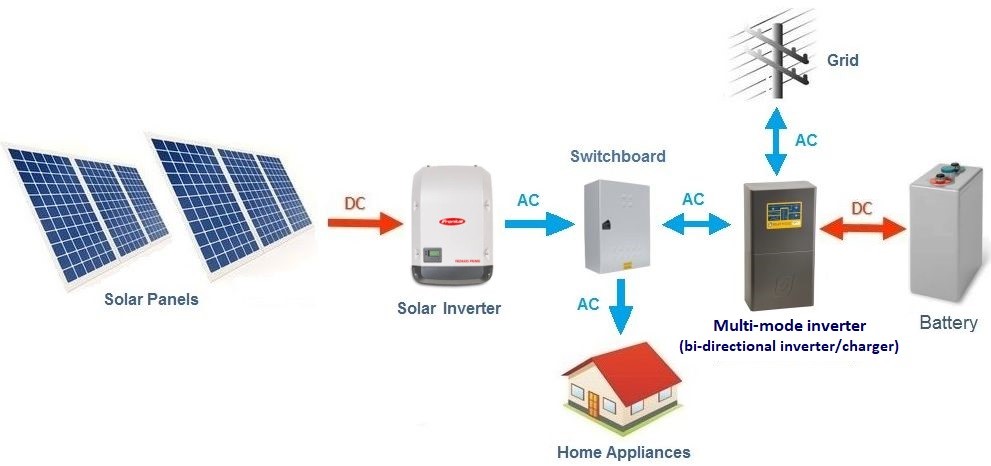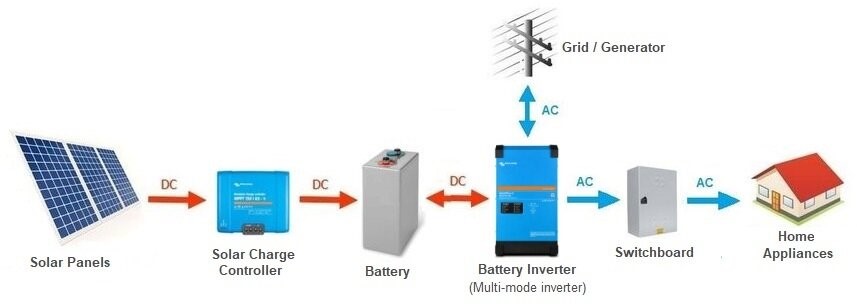As homes become increasingly reliant on electricity for cooking, water heating, and space conditioning, a blackout becomes more disruptive. These blackouts often occur during storms and extreme temperatures, a time when a power loss can result in frozen and burst pipes or dangerous temperatures. Backup power has traditionally been supplied by fossil fuel-based standby generators powered by propane, natural gas, diesel, or gasoline. These backup generators require periodic maintenance including coolant and oil level checks and replacements, starter battery check and replacements, and load tests. These monthly and annual maintenance chores can be avoided with battery-based backup solutions.
Lithium-based battery storage systems are basically maintenance free for the life of the batteries, which is usually over 10 years.
Batteries have an important additional benefit, unavailable to fossil-fuel generators – they can be recharged by the sun (Figure 1). Battery back up systems can last about a day when set up to run some but not all of a home’s circuits, before the battery will need to be recharged. This varies greatly depending on the size and type of system bought. In some cases, multiple batteries can be strung together as well depending on the system.

Another advantage of battery systems is that for homes with solar (or wind power) they can be used by the homeowner year round, not just during power outages, to help supply the homeowners’ power needs during the evening peak power demand times when homeowners are typically using large amounts of power for lights, space heating or cooling, plug loads, etc. but the sun has set and is no longer producing power. Rooftop solar systems can utilize batteries to reduce the amount of energy sold and purchased from the grid. This can be especially appealing for homeowners in utility markets that provide less-than-retail net metering rates for the power they purchase from owners of home PV systems. For markets with large price swings in time-of-use electric rates, batteries can be charged during low-cost times of day to supply “free” power to the home during high cost-per-kWh periods. Thus, they can reduce the total amount of high-cost energy the homeowners will need to purchase.
Note that if the battery gets completely depleted, some AC batteries will require the battery to receive a signal from the grid in order to begin charging again, while most DC batteries have a black-start capability (described below) which allows them to restart with solar power alone. See below and the references for more on the features, advantages and disadvantages of each. The number of AC-coupled and DC-coupled energy storage systems (batteries) on the market is constantly expanding; thus, it is recommended to reference recent articles and talk over your options with several PV vendors before making a decision.
The cost of lithium-based stationary battery storage has fallen to the level where they are starting to become affordable. Do-it-yourself solutions where the batteries are assembled from new raw lithium cells or used cells can result in battery storage solutions that are very cost effective. This guide will not address the details or safety precautions needed to construct a DIY stationary battery storage solution. Retail turn-key battery solutions, such as the Tesla Powerwall and the Enphase Encharge battery, are still priced as premium products. Thus, they may not be seen as cost-effective solutions compared to a generator if backup power during a blackout is the only desired feature. However, if the additional benefit of year-round utility bill savings, makes economic sense, the combined benefits may justify the cost of battery-based backup power.
AC-Coupled and DC-Coupled Energy Storage Systems (ESS)
When looking for a battery-based backup power solution, you will encounter two different configurations: AC-coupled batteries and DC-coupled batteries (Figure 2 and 3). AC-coupled batteries feature a built-in inverter that allows the battery to operate as an all-in-one solution for providing backup power during a blackout with or without solar. DC-coupled batteries are installed on the DC side of an inverter and harness the main inverter in an on-site renewable energy generation system to make usable AC power. For homes with an existing central inverter-based on-site renewable energy generation system, a DC-coupled battery is often the least cost and most power efficient way to add energy storage to provide backup power during a blackout.


Black Start Capable
For those interested in backup power for an extended multi-day blackout, the ability to black start the inverter can be an important feature. This scenario occurs when the batteries are depleted all the way to the low voltage cutoff at which point to the inverter will shut down. If, the next morning, renewable energy from the rooftop solar panels is available, can that energy be used to charge the battery and restart the inverter even if grid power is still not available, i.e., can the system “black start”? For many grid-tied renewable energy systems, the answer is no. This is due to IEEE (Institute of Electrical and Electronics Engineers) safety standards the equipment must meet to avoid back feeding energy into the grid and endangering linemen making repairs. Most, if not all, AC-coupled batteries need to see an AC signal before they will start up (Soltaro 2021). The same is true for micro-inverters and a large number of central grid-tied inverters. However, there are inverters called bi-modal, multi-modal, or hybrid inverters that can work with DC-coupled batteries and restart even without seeing an AC signal (Clean Energy Reviews 2021b, 2021c). These inverters are able operate in off-grid mode; they can use power from the solar panels to charge the battery and start the inverter, without seeing an AC signal, i.e., black start, and then AC sync with the grid once power is restored.
Subpanel and Automatic Transfer Switch
Regardless of whether batteries or a generator are selected as the means of providing power during a blackout, it is essential that the backup power does not back feed the grid and endanger linemen making repairs. To prevent this from occurring, backup power systems must have automatic transfer switches that disconnect the house from the grid while the backup power system is operating. Often, the home also has a critical loads subpanel because the backup power system was not sized to power the entire house but only the critical loads. The subpanel allows these critical loads to be isolated and the backup power supplied to only these loads.
Compliance
Requirements for solar PV systems installation, location, and storage can be found in the International Energy Conservation Code, the International Residential Code, and the National Electric Code. The 2021 IECC describes requirements for the solar-ready zone of residential buildings in Appendix RB, which can be used to determine the proper placement of solar PV systems and the energy storage systems that accompany them. In the 2021 IRC, Sections R324 and R328 describe requirements for the installation of solar energy systems and the location and operation of energy storage systems. The 2020 National Electric Code focuses on general requirements for solar PV systems in section 690, specifically highlighting battery storage for solar PV systems in part VIII.
More Info
The following authors and organizations contributed to the content in this Guide.